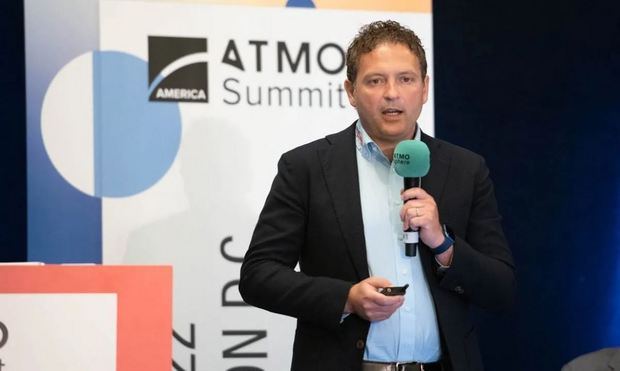CO2 Chillers Have ‘Great Potential’ for Combined Cooling and Heating Applications

Italian compressor manufacturer Dorin has tested a process-cooling CO2 (R744) chiller in several North American climate zones and found that they have “great potential” in combined cooling and heating applications.
This conclusion was shared by Giacomo Pisano, Business Development Manager for CO2 Compressors at Dorin, who spoke during the ATMO America conference.
Dorin tested the CO2 chiller in four different North American climate profiles: New York, Montreal, Houston and Los Angeles. With an R513a system as a comparison reference, Dorin found that a basic CO2 system has an efficiency penalty in the warmer climates, but adding adiabatic cooling improves the efficiency. Adding ejectors improves the efficiency even further.
The CO2 chiller presented by Pisano is assumed to be operating year round, meaning it has a strong dependence on ambient temperatures. It is designed to deliver 40°F (5°C) water. So far, heat recovery is not included.
In Europe CO2 chillers have been available since 2017, and they are becoming more and more popular, according to Pisano.
Efficiency-improving technologies
Because there are no charge restrictions for CO2, systems do not have to be designed as dry expansion (DX). The oils used for CO2 compressors are partly miscible and can therefore easily be drained from the bottom of any receiver. This means that overfeeding the evaporators is a possibility, Pisano said, noting that this is normally done by gravity. The gravity-overfed evaporators are standard for CO2 chillers nowadays, he added.
Adding ejectors to lift the suction pressure of the compressor is also an option, which can give a “very strong” COP improvement, according to Pisano. The efficiency can also be improved by adding an adiabatic gas cooler, which can lower the discharge pressure. “Clearly, adiabatic cooling is beneficial to any technology,” Pisano said, after sharing measurements from an installation in China.
Looking at capital system cost, Pisano shared general figures for a system of 70TR (246.2kW) that Dorin has gathered from European OEMs, concluding that a CO2 chiller costs around 60% more than an HFO system. Since they are collected from European companies, the figures might not be entirely applicable for the U.S. market, he stressed.
Other natural refrigerant chillers
During his talk, Pisano also mentioned ammonia/NH3 (R717) and hydrocarbon chillers, both long available in the market. Ammonia chillers can be restricted by limitations to the refrigerant charge, but new low-charge technology means this is no longer an issue in many cases. Accordingly, Pisano said, “Definitely ammonia is a great technology to be considered for DX for chillers.” Propane (R290) chillers are also becoming more and more popular, especially in Europe, and are available in all sizes, he noted.
